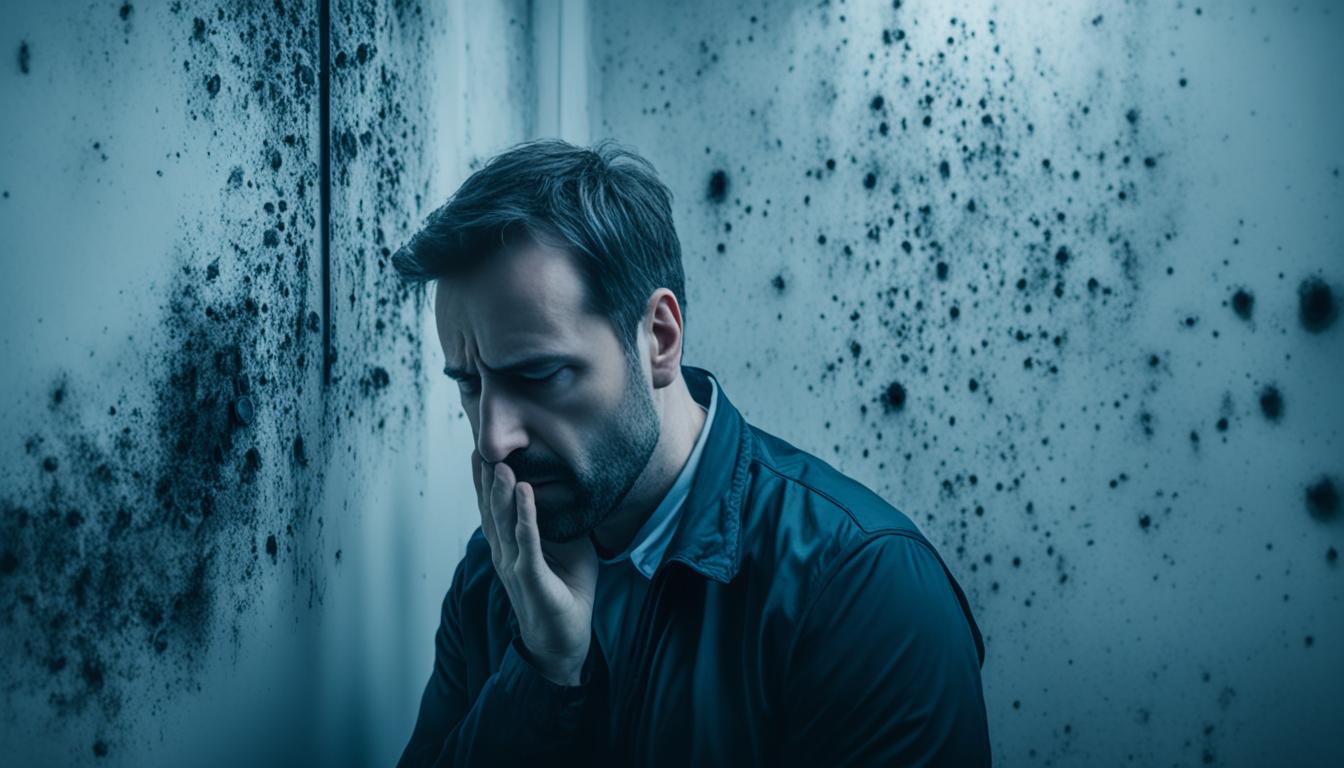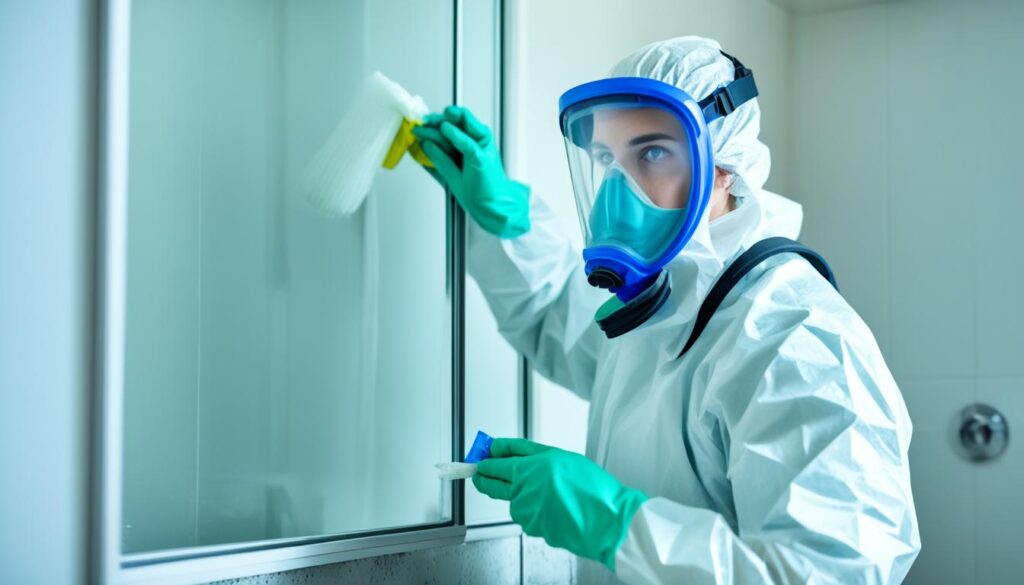
Black Mold Exposure Symptoms Guide & Tips
Discovering black mold in your home can be concerning, as it can pose serious health risks. Understanding the symptoms of black mold exposure is crucial for prompt action and prevention. In this guide, we will explore the signs of black mold exposure symptoms and provide valuable tips to safeguard your well-being.
Black mold exposure can lead to a range of physical and psychological symptoms. These may include respiratory issues, such as coughing, wheezing, and throat irritation. Other common symptoms include headaches, fatigue, allergies, and skin rashes. It’s essential to recognize these signs to address any potential health issues caused by black mold in your environment.
Key Takeaways:
- Recognize the signs of black mold exposure symptoms, including respiratory issues, headaches, fatigue, allergies, and skin rashes.
- Promptly address any black mold growth or water leaks in your home or workplace.
- Maintain proper ventilation and control moisture levels to prevent the growth of black mold.
- Seek professional assistance for mold assessment and remediation to ensure effective removal.
- Protect yourself and loved ones by creating a safe and mold-free living environment.
Understanding Black Mold Exposure Symptoms
When it comes to black mold exposure, understanding the symptoms is crucial for prompt detection and appropriate action. Black mold, also known as Stachybotrys chartarum, can release spores that, when inhaled or ingested, may cause a range of health issues. In this section, we will explore the various physical and psychological signs that individuals may experience after exposure to black mold. By recognizing these symptoms, you can take the necessary steps to protect yourself and your loved ones.
Physical Symptoms of Black Mold Exposure
Exposure to black mold can lead to several physical symptoms, which may vary depending on the individual’s sensitivity and the level of exposure. Common physical symptoms may include:
- Respiratory issues: Black mold spores can irritate the respiratory system, leading to coughing, wheezing, and difficulty breathing.
- Allergic reactions: Some people may develop allergic reactions to black mold exposure, experiencing symptoms such as nasal congestion, sneezing, itchy eyes, and skin rashes.
- Headaches and dizziness: Prolonged exposure to black mold may cause persistent headaches and recurrent episodes of dizziness.
- Fatigue and weakness: Individuals exposed to black mold may often feel fatigued, weak, and lacking in energy.
- Muscle aches and joint pain: Black mold exposure can result in muscle aches, joint pain, and general discomfort.
Psychological Symptoms of Black Mold Exposure
In addition to physical symptoms, black mold exposure can also affect an individual’s mental well-being. Psychological symptoms may include:
- Brain fog and memory problems: Some individuals may experience difficulty concentrating, memory problems, and overall mental confusion.
- Mood swings and depression: Prolonged exposure to black mold may contribute to mood swings, depressive symptoms, and an overall decline in emotional well-being.
- Anxiety and panic attacks: Black mold exposure can trigger feelings of anxiety and panic attacks in susceptible individuals.
Recognizing and understanding these symptoms is essential in identifying potential health issues related to black mold exposure. If you or someone you know is experiencing any of these symptoms, it is important to seek medical attention and address the underlying cause. Taking action promptly can help prevent further complications and ensure a safer living environment for everyone involved.
Remember, prevention and early detection are key in protecting yourself from the harmful effects of black mold. Take proactive measures to reduce moisture levels, ensure proper ventilation, and promptly address any signs of water leaks or mold growth in your surroundings. By staying informed and proactive, you can safeguard your health and well-being.
Symptoms of Black Mold Exposure
| Physical Symptoms | Psychological Symptoms |
|---|---|
| Respiratory issues | Brain fog and memory problems |
| Allergic reactions | Mood swings and depression |
| Headaches and dizziness | Anxiety and panic attacks |
| Fatigue and weakness | |
| Muscle aches and joint pain |

Prevention Tips for Black Mold Exposure
Preventing black mold exposure in your home or workplace is essential for creating a safe and healthy environment. By taking proactive measures and following these practical tips, you can minimize the risk of black mold growth and safeguard your well-being.
1. Maintain Proper Ventilation

Proper ventilation is crucial to prevent black mold growth. Ensure good airflow throughout your space by opening windows, using exhaust fans in humid areas such as kitchens and bathrooms, and regularly cleaning and maintaining ventilation systems and air conditioning units. Adequate ventilation helps to reduce moisture levels, preventing the conditions that favor black mold development.
2. Control Moisture Levels
Moisture is a primary factor that promotes black mold growth. To prevent excess moisture in your home or workplace:
- Repair any water leaks promptly.
- Regularly check and maintain your plumbing system.
- Monitor and address any signs of water damage, such as stains, discoloration, or dampness.
- Use dehumidifiers in areas with high humidity.
- Ensure proper drainage around your property to redirect water away from the foundation.
3. Address Water Leaks and Mold Growth
“The presence of water leaks is a red flag for potential black mold growth.”
Water leaks provide a conducive environment for mold to thrive. If you notice any signs of water leaks, such as water stains on walls or ceilings, musty odors, or visible mold growth, it is crucial to address the issue promptly.
- Identify and repair the source of the water leak.
- Thoroughly dry affected areas within 48 hours to prevent mold growth.
- Consult with a professional mold remediation expert, like Fix Mold Miami at 305-465-6653, for proper assessment and remediation of mold-infested areas.
By promptly addressing water leaks and mold growth, you can prevent the spread of black mold and mitigate potential health risks.
4. Regularly Clean and Maintain
Regular cleaning and maintenance play a crucial role in preventing black mold. Follow these tips:
- Clean and dry bathrooms and kitchens regularly, paying special attention to areas prone to moisture.
- Use mold-resistant products for construction and remodeling projects.
- Regularly inspect and clean air conditioning filters, vents, and ducts.
- Keep indoor humidity levels between 30-50% to discourage mold growth.
By incorporating these cleaning and maintenance practices into your routine, you can minimize the risk of black mold exposure.
5. Monitor and Take Action
Regular monitoring allows you to detect and address any signs of black mold growth promptly. Be vigilant for the following indicators:
“Early detection and immediate action are crucial in preventing black mold exposure.”
- Musty odors, particularly in enclosed spaces.
- Visible mold growth on surfaces or in hidden areas, such as behind wallpaper or under carpets.
- Excessive moisture or condensation on windows or walls.
- Allergic reactions, such as persistent sneezing, coughing, or skin irritation, that worsen when indoors.
If you notice any of these signs, take immediate action to investigate and address the underlying cause to prevent further mold growth and potential health issues.
| Prevention Tip | Benefits |
|---|---|
| Maintain proper ventilation | Ensures adequate airflow and reduces moisture levels |
| Control moisture levels | Prevents excess moisture, a primary factor for mold growth |
| Address water leaks and mold growth | Prevents the spread of mold and mitigates health risks |
| Regularly clean and maintain | Minimizes the risk of mold growth through regular maintenance |
| Monitor and take action | Allows for early detection and prompt remediation |
Conclusion
In conclusion, it is essential to be aware of the symptoms associated with black mold exposure for the sake of your health. By understanding these signs, you can take the necessary steps to protect yourself and create a safe living environment. Remember that prevention is key, and implementing preventive measures can help minimize the risk of exposure to black mold.
If you suspect black mold in your home or workplace, it is crucial to seek professional help. Contact Fix Mold Miami at 305-465-6653 for a thorough mold assessment and effective mold remediation, ensuring a prompt resolution to any mold-related issues. Your well-being and that of your loved ones are worth safeguarding from the potential health risks linked to black mold exposure.
Take action today to create a mold-free environment and prioritize your health and safety. By staying informed and proactive, you can maintain a healthy living space and enjoy peace of mind.




